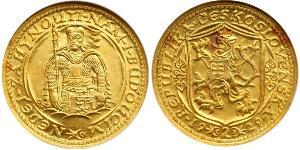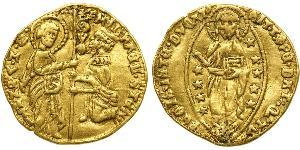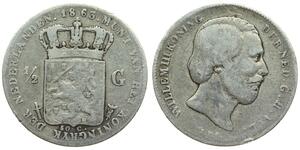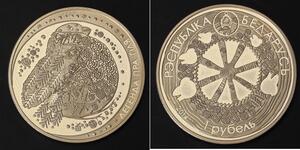1 Ducat (sold for $326.0)
1926, Czechoslovakia (Republic). Beautiful Gold "Saint Wenceslas" Ducat Coin. 3.49gm!
Mint Date: 1923
Mintage: 58,669 pcs.
Condition: A nice lustre AU-UNC!
Denomination: "Saint Wenceslas" Ducat
Reference: Friedberg 2, Schlumberger 27, KM-8. R!
Material: Gold (.986)
Diameter: 20mm
Weight: 3.49gm
Obverse: Armored standing figure of Good King Wenceslas, holding banner and shield.
Legend: NEDEJ - ZAHYNOUTI - NÁM - I - BUDOCIM >Cc
Reverse: Large shield with Bohemian lion with small shield of at shoulder.
Legend: REPUBLIKA CESKOSLVENSKA >Cc 1926 cC<
Saint Wenceslaus or Saint Wenceslas (c. 907 – September 28, 935) was duke (kníže) of Bohemia from 921 until his death. Wenceslas is best known in the English-speaking world as the subject of the Christmas carol "Good King Wenceslas."
He was the son of Vratislav I, Duke of Bohemia from the Přemyslid dynasty. His father was raised in a Christian milieu through his father, Bořivoj, who was converted by Saint Cyril and Saint Methodius, the "apostles to the Slavs". His mother Drahomíra was the daughter of a pagan tribal chief of Havolans and was baptized at the time of her marriage. Wenceslaus himself is venerated as Saint Wenceslaus and is the main patron saint of the Czech state.
em>.
The independence of Czechoslovakia was officially proclaimed in Prague on October 28, 1918 in Smetana Hall of the Municipal House, a physical setting strongly associated with nationalist feeling. The Slovaks officially joined the state two days later in the town of Martin. A temporary constitution was adopted and Tomáš Masaryk declared president on November 14. The Treaty of St. Germain, signed in September 1919 formally recognized the new republic. Ruthenia was later added to the Czech lands and Slovakia by the Treaty of Trianon (June, 1920). There were also various border conflicts between Poland and Czechoslovakia.
The new state was characterized by problems with its ethnic diversity, the separate histories and greatly differing religious, cultural, and social traditions of the Czechs and Slovaks. The Germans and Magyars (Hungarians) of Czechoslovakia openly agitated against the territorial settlements.
The new nation had a population of over 13.5 million. It had inherited 70 to 80% of all the industry of the Austro-Hungarian Empire. Czechoslovakia was one of the world's ten most industrialized countries. The Czech lands were far more industrialized than Slovakia. Most light and heavy industry were located in the Sudetenland and were owned by Germans and controlled by German-owned banks. The very backward Subcarpathian Ruthenia was essentially without industry.
The Czechoslovak state was conceived as a parliamentary democracy. The constitution identified the "Czechoslovak nation" as the creator and principal constituent of the Czechoslovak state and established Czech and Slovak as official languages. The concept of the Czechoslovak nation was necessary in order to justify the establishment of Czechoslovakia towards the world, because otherwise the statistical majority of the Czechs as compared to Germans would be rather weak. The operation of the new Czechoslovak government was distinguished by stability. Largely responsible for this were the well-organized political parties that emerged as the real centers of power.

|
Posted by:
anonymous 2014-01-29 |
|
||
|
||
|
||
|
||
50 Cent / 1/2 Gulden Kingdom of the Netherlands (1815 - ) Si ...
group has 13 coins / 13 prices
⇑
One of them is

-600-300-y8wKb0OMZ4QAAAFDm9LA4OBo.jpg)

-300-150-dBXBwcI0r0EAAAEqYKAoKieZ.jpg)
 Deutsch
Deutsch Русский
Русский Українська
Українська English
English Italiano
Italiano Français
Français Español
Español 汉语
汉语






-300-150-IHcKbzbizFcAAAFRpvtauxkd.jpg)







